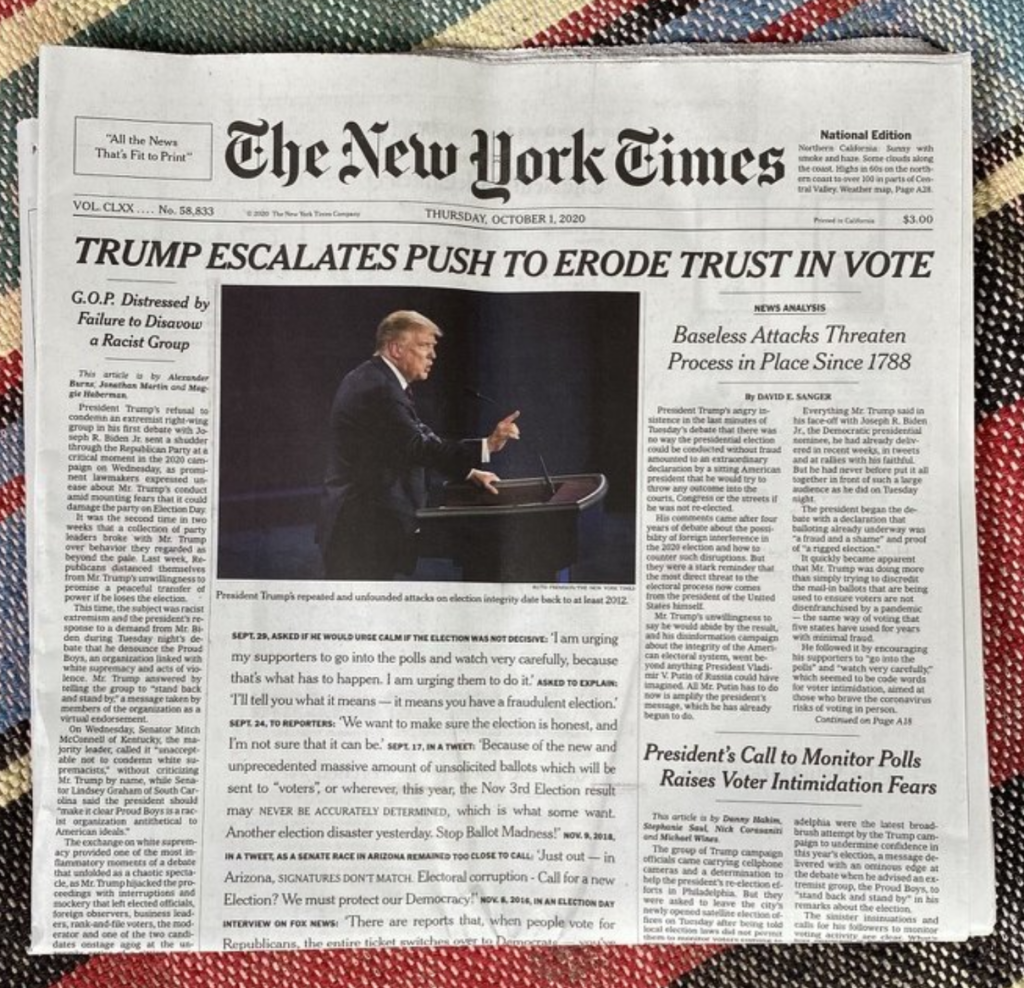How The New York Times ceded the election narrative to Trump — and what their coverage should include instead
by: Lori Dorfman
posted on Friday, October 02, 2020
The New York Times is known for its high caliber of journalism and its commitment to holding powerful people to account, but Thursday morning’s front page infuriated me.

On the surface, the headline, which spans the entire page, seems to pull back the veil on Donald Trump, noting that he is escalating his efforts to erode trust in the voting process.
And the writers no doubt think they’re countering his message by describing Trump’s tactics as “baseless attacks.” But, dig a little deeper, and it’s clear that, instead, the Times has lost control of the narrative.
For years — and, now, almost by the hour — Trump has undermined trust in the election (unless, of course, he wins). By repeating this frame, the Times and other media outlets have now cemented sufficient doubt in the public’s mind. For evidence of the mounting damage, see the paper’s own story on Wall Street’s jitters.
Just saying “he’s wrong” doesn’t counter the narrative because the counterpoint is occurring inside of a frame that the president has already set. Although not all reporters are steeped in framing theory and cognitive linguistics, New York University’s Jay Rosen has been explaining this concept to the Times for years. Additionally, Berkeley Media Studies Group regularly reminds journalists and advocates to establish their own frames because repeating false or misleading statements, even to rebut them, inadvertently reinforces them. As George Lakoff’s book Don’t Think of an Elephant demonstrates, when we tell audiences not to focus on something, we are putting the very thing we want to avoid top of mind and creating a hurdle that we now must jump over. Thursday’s front page was a stampede of elephant triggers.
In letting Trump control the narrative, the media lost the real election story: One of the longest and most vexing problems in United States elections is the large part of the electorate who does not vote. Compare us to any other country. Compare any year. The numbers are appalling. The New York Times needs to tell that story. When the real problems are voter apathy and voter suppression, shouldn’t we have much more reporting on that? What about the stories on all the groups that have been working diligently to reverse those trends? What are they doing? Are their strategies expected to work? Where are these efforts the most robust? Where do they need to be bolstered?
Take the youth vote. It has never reached its potential but could have a huge impact if large numbers of young people vote. Will this year be different? March for Our Lives co-founder David Hogg thinks so. Is he right? Where’s the big story on the youth vote?
Also, what’s happening with Stacey Abrams (founder of Fair Fight and the Southern Economic Advancement Project) and voting in Georgia and elsewhere in the South? Voter intimidation is certainly not new there. Where are the big stories on all the voting work being done?
Even philanthropy has stepped up. The Langeloth Foundation and others are supporting efforts to get out the vote. Where’s the story on what philanthropy is doing?
What about rural counties? When the (very problematic) electoral college has such an impact on election outcomes, shouldn’t we be hearing more about that? I shouldn’t have to learn about innovative efforts to challenge it from John Oliver.
Problems with election reporting are similar, believe it or not, to issues with violence reporting. BMSG research shows that when the most unusual and rare form of violence dominates the news, it makes it seem like homicide is the norm when, in fact, it’s relatively rare. Important, yes, but rare. Homicide, it turns out, is a distraction from the many types of violence we need to prevent. This distortion matters because if audiences don’t have a strong grasp on the nature and extent of a problem, then we can’t begin to agree on solutions.
Election news can’t just consist of Trump’s extreme cries. They are a distraction that allow him to set the terms of debate away from where we should focus. Readers need to hear the harder-to-tell but more important story about what is really going on with voting in the U.S. Although news outlets like the Times are publishing stories about the tribulations of voting amid a pandemic, we also need clearer, more robust coverage about the challenges of voting while Black and not voting at all.
Why isn’t the president using every power at his disposal to make sure people vote? To make it easier to vote? To be sure voting is safe? Where is that story? Where is that narrative? Major outlets like the Times have the ink; they need to use it. I just hope it’s not too late.



